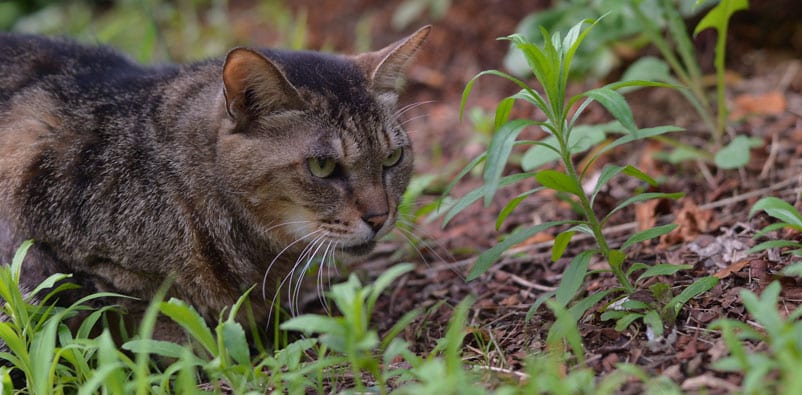
Photo: Eiji Ienaga on Flickr
Most cat owners are surprised to learn how far their free-range cat will actually travel, and the dangers they will encounter along the way.
Fortunately, we have some insight into both of these questions, thanks to research conducted in 2014 by Mya Gaby of Victoria University of Wellington. Her full report (see link below) is an excellent read, but I’ll summarise some of the highlights here.
Mya was particularly interested in tracking the behaviour of ordinary pet cats living near the Zealandia wildlife sanctuary in Wellington. She recruited ten cat owners from the area, and taught them how to fit a tiny video camera to their cat’s collar. The cameras were motion activated, and Mya analysed only their behaviour when outdoors.
Quoting from the report:
All ten cats exhibited at least one risk behaviour during the eight weeks of data collection.
The most common risk behaviours exhibited by suburban, domestic free-roaming cats in Wellington included:
climbing trees or onto a roof (80 per cent of individuals), entering crawl spaces (70 per cent), consuming liquids not left by owner (60 per cent), encountering cats that were not from the same household (60 per cent) and crossing roads (40 per cent).Most participants encountering cats (not from the same household) had non-aggressive encounters (76 per cent of the time). However, cat fights were witnessed with 40 per cent of participants engaging in one aggressive physical contact with a stranger cat.
The table below lists the type of risk behaviours witnessed via Eyenimal™ Cat Videocams and includes the collective sum for the number of times each was counted. Unexpectedly, we also found one cat entered a stranger’s home and nine out of ten cats in this study left their properties on at least one occasion.
| Risk Behaviour | Cumulative Count |
|---|---|
| Entering crawl spaces (Risk of getting stuck/trapped) |
32 |
| Climbing tree (Injury risk, Risk of getting stuck/trapped) |
19 |
| Consuming liquids not left by owner (Poisoning risk) |
16 |
| Non-aggressive contact with stranger cat (Disease risk) |
13 |
| Crossing road (Injury risk) |
6 |
| Aggressive contact with stranger cat (Injury risk, Disease risk) |
4 |
| Climbing on roof (Injury risk, Risk of getting stuck) |
3 |
Just a couple of comments about the table above:
- It identifies the risk of “crossing road” as “injury”. In our experience as cat breeders, cats struck by cars are more likely to be killed than injured.
- It doesn’t include risks such as simply walking onto a neighbour’s property. We have seen cases recently in New Zealand of cats being maimed in leghold traps set by hostile neighbours, or attacked by neighbours or their dogs.
- The cameras were only able to record for 2.5 hours at a stretch, so it is quite likely that a number of risky behaviours were not recorded.
Quoting again from the report:
In the United States the average life-expectancy of a strictly indoors pet cat versus a free-roaming pet cat varies dramatically, 12-18 years versus 3 years, respectively (Humane Society of the United States, 2013). This is likely due to free-roaming domestic cats exhibiting risk behaviours whilst outdoors.
Overseas, free-roaming cats may also encounter predators themselves, such as coyotes, whereas domestic cats in
New Zealand have no predators.
And:
Traffic accidents, conflict with other animals and exposure to poisons and disease are just some of the causes that can also contribute to free-roaming cat death. Domestic free-roaming cats contracting an infectious disease or obtaining an injury is of particular concern as more than half of our study cats were witnessed encountering stranger cats.
Cats in New Zealand can carry a number of diseases which includes, but is not limited to; toxoplasmosis, cat scratch disease and feline immunodeficiency virus (FIV). The exposure of cats to these diseases is heightened if cats are free-roaming, as they are more likely to come into contact with another infected individual.
Full report:
Mya A Gaby: A REPORT ON FREE-ROAMING DOMESTIC CAT ACTIVITIES IN URBAN AREAS
9 July 2016
